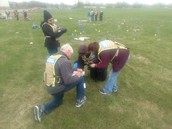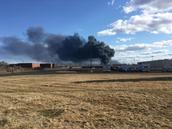
The Disaster Mortuary Emergency Response Team (DMERT) participated in the Minneapolis-St Paul Airport crash exercise on May 11. MDH EPR plays the role of coordination of the DMERT volunteers in the event of a mass casualty event. In preparation for the exercise, a notification call was sent to all team members the evening of May 10. It is important to test the after-hours, unannounced notification to ensure a coordinated response, should this type of incident occur.
This exercise tested the Mass Casualty Plan and allowed the team members to respond to the airport to assist with the search of the crash site. Team members, who are volunteers from across the state from several different specialties, also tested the computer systems that would be used for ante-mortem and post-mortem data entry. Twenty-two of the members from the team participated. Currently, the team consists of more than 60 individuals who may be asked to assist, if necessary.
At the conclusion of the exercise, the DMERT was better prepared to receive notification and to be ready to go as soon as they arrive on scene following an incident.
Click the link below to watch a short video about the exercise that shows the DMERT volunteers in action.
https://www.youtube.com/watch?v=Bj0EqSlMsww&feature=youtu.be
|
 When an explosion rocked the Husky Oil Refinery in Superior, WI, the Northeast Regional Public Health Preparedness Consultant, Marilyn Cluka's, first thought was how her skill set could be utilized in the response. During a public health emergency, she brings knowledge of state and local operations to fill gaps by connecting partners and resources as needed. When the local emergency manager called her in to the St. Louis County Emergency Operations Center (EOC), she was ready to go.
During a rapidly moving response, every second counts. Teams from St. Louis County moved quickly to support the Wisconsin-run response, standing up the EOC and assessing hospital and long term care bed availability in MNTRAC, the statewide tracking system. When a second fire ignited just as the first had been contained, St. Louis County was forced to prepare for the worst-case scenario: the possibility of 6,000-8,000 residents evacuating to the Duluth Entertainment Convention Center (DECC), hospital and long-term care evacuations, and a thick black smoke descending upon Superior and the surrounding areas. Even during the most stressful moments of uncertainty, Cluka noted that the team remained calm. They waited for situational updates, which eventually led to the de-escalation of the situation, and successful sheltering of fewer than 100 individuals overnight at the Duluth Entertainment and Convention Center (DECC).
Every emergency begins and ends locally: the investments Minnesota has made in innovative response systems, trained personnel, and cross-jurisdictional collaboration all contributed to a coordinated response supported by the City of Superior, St. Louis County and the states of MN and WI, in addition to numerous other internal and external partners.
|
Katie Triebold is the new Public Health Preparedness Consultant in the Central Region. She comes to MDH from CentraCare where she worked as the Director of Project BrainSafe. Prior to that she worked as the Regional Prevention Coordinator in the SE MN region providing TA and consultation to communities working on substance use prevention. Katie lives in Alexandria with her husband Isaac and four children. She is looking forward to her new career with MDH, EPR!
Sue Grafstrom is the new Public Health Preparedness Consultant serving the Northwest Region. She is currently completing her Masters of Public Health Degree at the University of Minnesota. She has experience as a Homeland Security Emergency Management Director for Roseau Country and prior to that spent 10 years working at LifeCare Medical Center in Roseau, MN as a grant administrator and foundation director. Sue lives in Roseau with her husband, Paul, and three children. She is excited to serve the Northwest region of Minnesota in continuing their work in public health preparedness.
Alvine Laure Ekame is the new Health Care System and Region Network for Ebola and High Consequence Infectious Disease (HCID) Planner in the Center for Emergency Preparedness and Response (EPR). She brings over twenty years of experience in infectious disease and health care system management and planning. Most recently, Alvine Laure served as the Statewide HIV Strategy Coordinator for IDEPC/MDH. She looks forward to learning more about HCID and the various activities of EPR!
Packing Your Digital "Go Bag"
Disaster and emergency apps can be helpful, both during a steady state and times of crisis. Below are four of our favorite apps, available for both iPhone and Android. For more information visit the Disaster Information Management Research Center website.
Responder Self-Care from the University of Minnesota Public Health aids those deployed to emergency response events in maintaining their own physical, emotional, and social wellbeing.
American Red Cross has a suite of apps with useful step-by-step instructions on what to do before/during/after natural disasters. The apps also include an "I'm Safe" feature to notify family and friends that you are okay.
ReUnite from the National Library of Medicine (NLM) provides the ability to upload missing person information for family reunification during and after disasters. It provides structured information to the NLM People Locator service.
SAMHSA Behavioral Health Disaster Response connects behavioral health responders to evidenced-based behavioral health resources for use in the field. Users can access pre-loaded resources when Internet connectivity is limited, locate nearby treatment facilities, search for key materials and share information with colleagues and survivors.
August 20, 2018 & September 21, 2018
Medical Countermeasures Updates
MN.TRAIN Course ID 1069979
Training on August 20 will be held at 10:00 AM EST; training on September 21 will be held at 1:00 PM EST. The focus of this webinar will be to provide an overview and training on MDH's new Mass Dispensing guidelines.
Click on the Course ID link above to register in MN.TRAIN.
September is National Preparedness Month
National Preparedness Month, recognized each September, reminds us that we all must prepare ourselves and our families, now and throughout the year, for emergencies. This year's theme is Disasters Happen. Prepare Now. Learn How.
The devastating hurricanes and wildfire of 2017 reminded the nation of the importance of preparing for disasters. You can visit the ready.gov website to learn more about National Preparedness Month, and follow along on the MDH social media channels throughout the month for useful public health preparedness information.
|